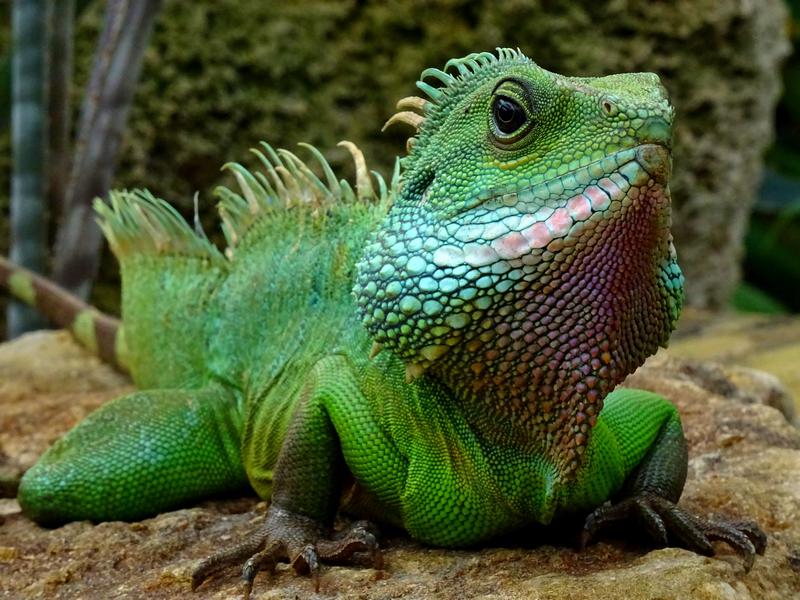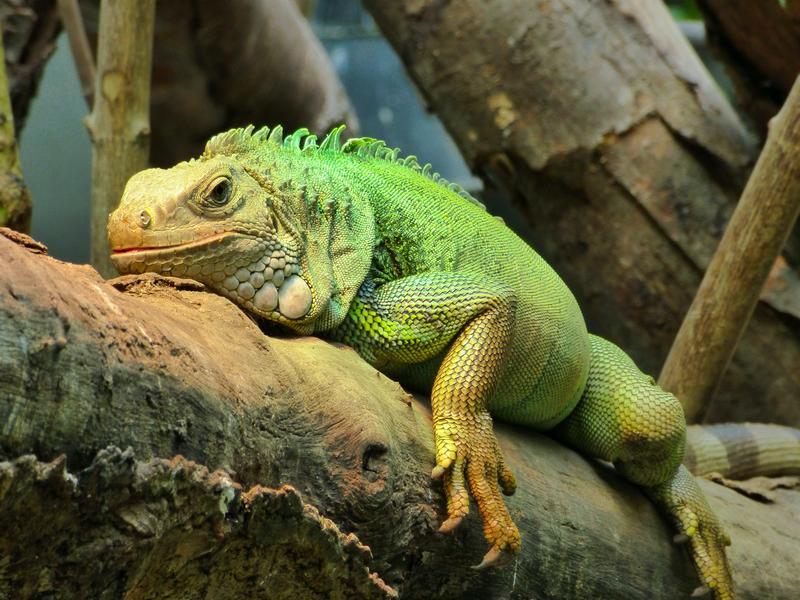Are Iguanas Dangerous to Dogs? How to Live Together Safely!
Are iguanas dangerous to dogs? In this article, we’ll shed light on whether iguanas are a threat to your dog (and vice versa), while also teaching you how to introduce iguanas and dogs in a safe and peaceful manner. We’ll discuss if iguanas attack dogs, and answer the unfortunate questions, can dogs eat iguanas, and what should you do if they have?
If you’ve encountered the horrible situation where your dog killed an iguana or bit an iguana, we’ll guide you on how to handle these incidents. We’ll also fill you in on if iguana poop is toxic to dogs, and what to do if your dog won’t stop barking at your iguana. Keep reading below for all this information and more!
Are Iguanas Dangerous to Dogs?

Yes, iguanas can be dangerous to dogs. While they’re not typically aggressive, iguanas have sharp teeth and claws, and a powerful tail they can use for defense. In addition, they can carry bacteria like Salmonella, which can cause serious illness if transmitted to dogs.
Can Iguanas Hurt Dogs?
Iguanas can hurt dogs. They possess sharp teeth and claws that can cause injuries if they feel threatened and choose to attack. Their tail, which they can whip about in self-defense, can also cause damage. It’s important to supervise all interactions between your dog and an iguana to prevent any potential harm.
Potential for Disease Transmission
Iguanas can carry Salmonella, a bacteria that can cause severe gastrointestinal illness in dogs. Transmission can occur through direct contact or if your dog comes into contact with the iguana’s droppings.
Can an Iguana Kill a Dog?
While an iguana’s defensive mechanisms can cause injury to a dog, it is highly unlikely that an iguana could kill a dog. The primary danger lies in potential bacterial infections, such as Salmonella, which, if left untreated, can be serious. However, prompt veterinary treatment typically resolves these infections.
Iguanas and Dogs: Ensuring Safe Interactions
The key to ensuring safe interactions between iguanas and dogs is careful supervision, proper socialization, and maintaining good hygiene practices to prevent bacterial transmission. It’s important, however, to remember that the underlying behavioral issues (prey drive, anxiety, overexcitement) that were causing all of this to begin with will still be present.
And until you address those, any positive changes you see are only going to be temporary.
“Well, how do I make these changes last?”
By getting your dog to truly choose to follow your direction, that’s how. I tried many times to write out how you can do this before deciding it made more sense to just link you to the free video series that explains it better than I’d ever be able to.
The series is by a man named Dan who is one of the world’s leading dog obedience trainers. In it, he teaches you how to put an end to things like when your dog isn’t getting along with your iguanas and all other misbehavior using his fast and easy-to-follow methods.
In the first video, Dan will reveal to you why the two most common methods of dog training only doom you to failure. You can watch the video now by clicking here. Follow the proven system he’ll show you in his series and you’ll never have to spend another second worrying about your dog not getting along with your iguanas ever again!
Iguanas and Dogs: How to Introduce

Iguanas and dogs should be introduced with caution, as dogs may view iguanas as prey due to their small size and unusual movements. It’s essential to keep both pets safe during the process. This introduction should occur gradually, with supervision, and ensure that both animals feel secure.
- Initial Separation: Initially, keep your iguana and dog in separate areas. This will allow both animals to get used to the smell and the presence of each other without any risk of direct contact or potential conflict. It’s a way to create a calm and safe environment for both pets during the first stage of the introduction process.
- Controlled Introduction: Once they’re used to each other’s scent, the first face-to-face meetings should be held with the dog leashed and the iguana secure in its enclosure or in your hands. Allow them to observe and sniff each other at a safe distance. Doing this in neutral territory is crucial to avoid territorial aggression from either animal.
- Monitor Reactions: It’s extremely important to pay close attention to the reactions of both pets. Any signs of fear, stress, or aggression indicate that the introduction is moving too fast, and you should take a step back. Both animals need time to adjust to the situation.
- Gradual Increase in Exposure: If they appear calm, gradually increase the length and proximity of their interactions, always under strict supervision. If both pets continue to seem calm and unbothered by the other’s presence, they are likely to become more comfortable with each other.
- Never Leave Them Unsupervised: Even if your iguanas and dogs seem to get along well, never leave them alone together without supervision. The size difference and natural instincts of the dog pose a potential risk to the iguana that shouldn’t be ignored.
Remember, not all iguanas and dogs will react in the same ways. It may take time for them to adjust to each other, and in some cases, cohabitation may not be possible. Always prioritize their safety and address any underlying behavioral issues, which we explain how to do in the first section.
It’s very important that you get a handle on any problems your pup has now or they’ll likely have difficulty with other animals as well. The same things that drive them to not get along with your reptiles will also cause geckos and dogs, hamsters and dogs, chinchillas and dogs, salamanders and dogs, dogs and guinea pigs, and of course, even ferrets and dogs to not get along either.
Do Iguanas Attack Dogs?
Iguanas do not attack dogs unless they feel threatened generally. As creatures that lean more towards self-preservation, they would rather evade than engage in confrontation. However, when cornered or frightened, they are capable of defending themselves.
Here’s an in-depth look into interactions between iguanas and dogs:
- Understanding Iguanas’ Defense Mechanisms: Iguanas possess several forms of defensive mechanisms to protect themselves in threatening situations. They are known to use their powerful tails in a whipping action and can bite to fend off perceived threats. Thus, if a dog approaches in a way that the iguana interprets as aggressive or intrusive, the iguana might employ these defenses.
- Iguanas are Typically Non-Aggressive Creatures: While iguanas are well-equipped to protect themselves, their default behavior is non-aggression. More often than not, faced with potential danger, an iguana will choose to retreat or find a place to hide rather than stand its ground and fight.
- The Role of Size in Interactions: The relative sizes of iguanas and dogs can play a significant role in their interactions. Larger iguanas may be more confident and thus more likely to defend their space against a dog. Conversely, smaller iguanas, feeling more vulnerable, will typically choose to avoid confrontation at all costs.
- The Importance of Supervised Interactions: To prevent any negative interactions, it is of utmost importance that your iguanas and dogs are not left unsupervised together. Even the most well-meaning and gentle dog can inadvertently trigger a defensive reaction from an iguana if they invade its personal space or engage too energetically.
- Address Underlying Problems: If you have iguanas and dogs in the same household and can’t keep your pup calm, you likely have an underlying behavioral problem that is driving things. Go back to the first section where we’ll explain how to handle this.
To ensure the safety and well-being of both pets, always monitor their interactions closely and respect their individual boundaries. When introducing and maintaining a harmonious coexistence between dogs and iguanas, it’s always best to err on the side of caution.
Can Dogs Eat Iguanas?
No, dogs cannot eat iguanas. Eating an iguana can pose significant health risks to dogs, including physical injuries from the iguana’s defenses, and potential infections from bacteria the iguana may carry, such as Salmonella.
What to Do if Your Dog Eats an Iguana
If your dog eats an iguana, you should contact a veterinarian immediately. Iguanas have sharp bones that can potentially cause internal damage to your dog. Additionally, iguanas can carry harmful bacteria, such as Salmonella, which can lead to serious illnesses in dogs if ingested.
My Dog Ate an Iguana: Potential Complications
If your dog has eaten an iguana, they may experience a number of potential complications. These include gastrointestinal upset, bacterial infections, and physical injuries caused by the iguana’s bones or defensive measures. In rare cases, serious or life-threatening conditions can develop, particularly if the dog ingests a large amount of the iguana or if bacteria are transmitted.
Bacterial Infection Risks
Iguanas often carry bacteria such as Salmonella in their digestive systems. If a dog eats an iguana, they may ingest this bacteria, leading to a Salmonella infection. This can cause symptoms such as vomiting, diarrhea, fever, and loss of appetite in your dog. If your dog shows any of these signs after eating an iguana, seek veterinary care immediately.
Preventing Dogs from Eating Iguanas
The best way to prevent your dog from eating iguanas is to supervise your pet when they’re outside, especially in areas where iguanas are known to live. Train your dog to follow commands like “leave it” or “drop it” can also be beneficial. Learn how to ensure safe interactions in the first section.
Dogs should not eat iguanas due to the significant health risks involved. If your dog eats an iguana, seek immediate veterinary attention.
My Dog Killed an Iguana
It’s a heart-wrenching scenario when your dog kills an iguana, whether it’s a pet or a wild animal. Such incidents often result from a dog’s inherent predatory instincts or playful curiosity turned aggressive. To prevent future occurrences and mitigate the aftermath, it’s vital to understand the causes, manage your dog’s behavior, and address potential health concerns.
- Understanding Your Dog’s Behavior: Dogs are predators by nature, and their instincts can be triggered by small, fast-moving creatures like iguanas. Even dogs that are generally well-behaved can find the movement and behavior of an iguana to be an irresistible trigger.
- Managing Predatory Instincts: If your dog has demonstrated a strong predatory response to small animals, it’s important to work with them on their underlying behavioral issues. This can help you manage these instincts and prevent harmful interactions in the future. We explain how in the first section.
- Health Concerns: Depending on the circumstances, your dog might be at risk of health issues if it killed an iguana. If your dog bit or ingested the iguana, it could be exposed to parasites or bacteria. Contact your vet immediately to discuss any potential risks and necessary actions.
- Dealing with Guilt and Grief: You might be feeling a mixture of guilt and grief, especially if the iguana was a pet. It’s important to remember that this was likely a result of natural instincts rather than malicious intent on your dog’s part.
- Preventive Measures: Prevent such incidents from happening again by providing secure housing for any small pets and closely supervising interactions. It’s also crucial to keep your dog on a leash when in environments where encounters with small animals are likely.
Remember, prevention is the best cure. Understanding your dog’s behavior, seeking professional advice, and taking appropriate precautions can help ensure a safe environment for all your pets and wildlife. Learn how to do these in the first section.
My Dog Bit an Iguana
If your dog bit an iguana, it’s important to address the situation promptly. In this instance, you need to check both the iguana and your dog for injuries, consult a vet, and think about measures to prevent such incidents in the future.
- Check the Iguana: The first step is to check the iguana for any visible injuries. If your pet iguana has been bitten, it will likely be in shock and need immediate veterinary care. If the iguana is wild, contact a local wildlife rehabilitation center.
- Inspect Your Dog: Check your dog for any injuries as well, as iguanas can bite or scratch in self-defense. Even minor wounds should be cleaned and monitored to prevent infection.
- Consult a Veterinarian: It’s recommended to consult a vet, even if no injuries are apparent. There may be risks of disease transmission or internal injuries not visible to the untrained eye.
- Train and Supervise: Address the behavior issue with your dog. You may need to seek help from a professional trainer or behaviorist to manage your dog’s impulse control and predatory instincts.
- Prevent Future Incidents: If you own an iguana as well as a dog, ensure that their living spaces are separate and secure. If the encounter was with a wild iguana, consider keeping your dog on a leash in areas where iguanas may be present.
Remember, responsible pet ownership involves understanding and managing our pets’ natural instincts, and ensuring that they live in a safe and controlled environment. Learn how to make things safe in the first section.
Is Iguana Poop Toxic to Dogs?
Yes, iguana poop is toxic to dogs if ingested. It often contains Salmonella bacteria, which can lead to serious gastrointestinal issues in dogs. Immediate veterinary attention is necessary if your dog consumes iguana feces.
Potential Risks of Ingesting Iguana Feces
When a dog eats iguana poop, the primary concern is the risk of a Salmonella infection. This bacteria can cause gastrointestinal upset, including symptoms like vomiting, diarrhea, loss of appetite, and fever. In severe cases, it can lead to more serious health issues such as sepsis, an extreme response to infection that can be life-threatening.
What to Do if Your Dog Ingests Iguana Feces
If your dog ingests iguana feces, immediately contact your veterinarian. Given the high likelihood of bacterial contamination, it is important to initiate medical intervention as soon as possible. Your vet may perform a physical examination, run diagnostic tests, and administer appropriate treatments such as antibiotics or fluids.
Preventing Dogs from Eating Iguana Feces
Prevention is the best strategy to avoid potential health risks. If you have your own or live in an area where iguanas are common, keep your dog supervised during outdoor activities and train them to avoid unknown substances. Regularly clean your yard to remove potential sources of iguana feces.
Iguana feces are toxic to dogs due to the high risk of Salmonella infection. If you suspect your dog has ingested iguana feces, seek immediate veterinary attention. To learn how to prevent future misbehavior from your dog around iguanas or their feces, go back to the first section now.
How to Stop Dog Barking at Iguanas
To stop a dog from barking at iguanas, you can use a combination of training techniques, such as the “quiet” command, distraction, and positive reinforcement. The “quiet” command is trained by waiting for your dog to stop barking, saying “quiet”, and rewarding them when they respond.
Training the ‘Quiet’ Command
Teaching your dog the ‘quiet’ command is an effective way to manage their barking. When your dog starts barking, wait for a pause and then say ‘quiet’ in a firm yet calm voice. As soon as your dog stops barking, reward them with a treat or praise. Repeat this process until your dog associates the command with ceasing to bark.
Using Distractions
Another way to stop your dog from barking at iguanas is to distract them, which is simple to do. When your dog barks at iguanas, just divert their attention with a favorite toy or game. This can help redirect your dog’s focus from the iguana and eventually break the habit of barking at them.
Positive Reinforcement
Remember to reward your dog when they do not react to an iguana. Positive reinforcement is a powerful training tool and can help reinforce the desired behavior. This could be a treat, a petting session, or a favorite game whenever they stay calm in the presence of an iguana.
Addressing Underlying Problems
If your dog’s barking becomes excessive or if you struggle with training commands, you likely have an underlying behavioral issue that needs to be addressed first. We explain how you can do that yourself in the first section.
In summary, to stop your dog from barking at iguanas, a combination of training techniques like the ‘quiet’ command, distraction, and positive reinforcement can be effective. Patience and consistency are key, and with time your dog should learn to stay calm when an iguana is present.
I’m sure you’re looking forward to a stress-free home for your iguanas and dogs, so I’ll let you get started now. Good luck with everything, and thank you for reading our article “Are Iguanas Dangerous to Dogs? How to Live Together Safely!”





